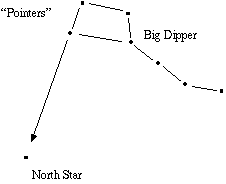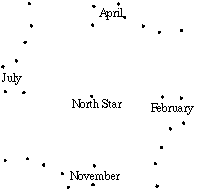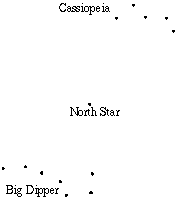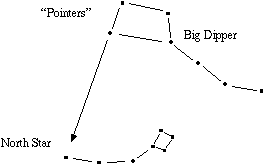
Find the Dipper and the North Star
The ability to find the North Star (Polaris) is useful for finding your way at night and for orienting yourself to constellations in the night sky.
Start from a location shielded from bright lights with a clear northern horizon. Initially, use a magnetic compass or a map to determine the north direction. Note that a magnetic compass points about 14 degrees east of north at Los Angeles.
Once you have determined the north direction, look up about one third* of the way from horizon to zenith, the top of the sky. The North Star is fairly bright (second magnitude) and visible from the city, but not as bright as the brightest stars (first magnitude).

Once you have gotten familiar with the shape of the Big Dipper, you can usually locate it quickly and use it to find the North Star. The position of the Dipper around the North Star depends on the time of night and the month of the year. A rotating star chart can give you this information, or use the diagram below, which shows the position of the the bowl of the Dipper in early evening according to the month.

In the fall season it is more difficult to see the Dipper from a location as far south as Los Angeles. Some of its stars are likely to be lost in the horizons mists. Then, the "W" of Cassiopeia may help to orient you towards the North Star.

The North Star is the last star in the handle of the Little Dipper.

The Little Dipper is a dimmer constellation, and not all of of its stars are visible from the city. The North Star and the last two stars of the bowl are usually visible. Note that the handle of the Little Dipper has the reverse curve of the handle of the Big Dipper.
Back to K-6 Page